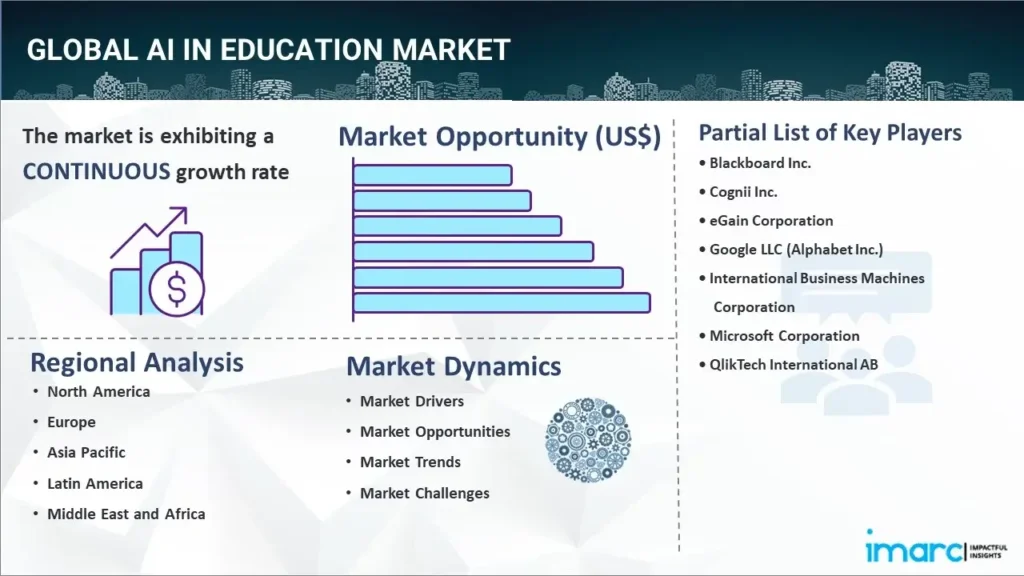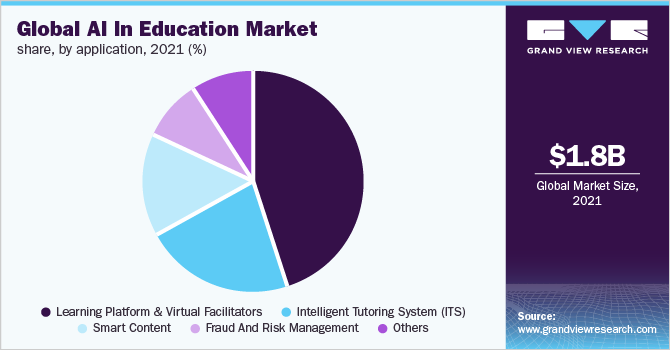AI in EdTech Market Size (2024-2030): Comprehensive Analysis
Multiple Report Analysis & Median Projections of Market Size & Opportunities in the EdTech AI Landscape.
Introduction

Determining the market size for AI EdTech is a difficult ask. Having scoured various reliable sources, we discovered that there is often a lot of variance in the numbers reported not only for today’s market size (2024) but also in the projected CAGR with some going as low as 10% and others as high as 47%.
In order to dispel the myths about the growth rate as well as current market size, we decided to take an approach of aggregating the median CAGR, the median market size and then the projected 2030 $ value based on this, as well as compiling some of our key findings along the way about: who are the key players, who is adopting AI and which regions are poised for growth.
We have aggregated information from several sources, listed at the end of this article and we have come to a consensus conclusion about the rapid growth of AI in edTech.
Reports on the EdTech AI Market

Here are some of the leading reports detailing their projections for the AI in EdTech market growth from 2024-2023:
- IMARC Group: Projects the market to grow from USD 3.5 billion in 2023 to USD 55.3 billion by 2032, with a CAGR of approximately 35.82% (IMARC Group).
- GMI Insights: Reports the market size was USD 4 billion in 2022, projecting it to reach USD 30 billion by 2032, with a CAGR of around 10% (Global Market Insights Inc.).
- Grand View Research: Estimates the market to grow from USD 2.75 billion in 2022 to USD 32.27 billion by 2030, with a CAGR of 36.0% (Grand View Research).
- P&S Market Research: Projects the market size to grow from USD 5.44 billion in 2024 to USD 55.44 billion by 2030, with a CAGR of 47.2% (P&S Market Research).
- Market.us Report: Projects the market to grow from USD 5.04 billion in 2024 to USD 31.0 billion by 2030, with a CAGR of 35.0% (Market US)
Dismissing the GMI Insights Report
OK, so we reach our first issue with these figures, they are fairly divergent with projections ranging from USD c. 30 billion – 55 billion, but the bigger issue is that the GMI projection also doesn’t make mathematical sense, so whilst the resulting figure may be based on solid logic / reasoning, we have to exclude it from the sample size for the purposes of the exercise. Here is the breakdown of why a 10% CAGR from a $4B to a $30B 10Y period doesn’t add up:
- If we use the 10% CAGR over 10 years (2022 to 2032): 4 billion * (1 + 0.10)^10 ≈ 10.37 billion This falls far short of the projected 30 billion.
- To reach 30 billion from 4 billion over 10 years, the actual CAGR would be: CAGR = (30/4)^(1/10) – 1 ≈ 0.2246 or about 22.46%
This 22.46% CAGR is significantly higher than the reported “around 10%”.
Conclusion: The information as presented doesn’t make mathematical sense.
- The CAGR is incorrectly reported and is actually closer to 22.46%.
- The projected market size for 2032 is overstated.
- The starting market size for 2022 is understated.
- There might be a typo or error in one or more of the figures.
To make this information consistent, one of these numbers would need to be adjusted. For example, with a 10% CAGR, the 2032 projection should be around 10.37 billion, not 30 billion, if starting from 4 billion in 2022.
For the purposes of this report, we will be ignoring the GMI Report and instead we’ll be looking at the other reports to create a median and work from this assumption.
Calculations to Determine the 2024 Market Size

To calculate the 2024 market size from the different reports, we need to use the given CAGRs and apply them to the appropriate base years to project the market sizes for 2024. Below are the calculations:
1. IMARC Group
- Projection: USD 3.5 billion in 2023 to USD 55.3 billion by 2032, with a CAGR of 35.82%.
- 2024 Market Size: USD 4.75 billion
2. Grand View Research
- Projection: USD 2.75 billion in 2022 to USD 32.27 billion by 2030, with a CAGR of 36.0%.
- 2024 Market Size:USD 5.09 billion
3. P&S Market Research
- Projection: USD 5.44 billion in 2024 to USD 55.44 billion by 2030, with a CAGR of 47.2%.
- 2024 Market Size: USD 5.44 billion
4. Market.us Report
- Projection: USD 5.04 billion in 2024 to USD 31.0 billion by 2030, with a CAGR of 35.0%.
- 2024 Market Size: USD 5.04 billion
How Big is the AI EdTech Market in 2024?
Based on the provided projections and calculations, the market size of the AI in EdTech Market in 2024 is USD 5.065 billion, based on the median value of four leading research groups:
- IMARC Group: USD 4.75 billion
- Grand View Research: USD 5.09 billion
- P&S Market Research: USD 5.44 billion
- Market.us Report: USD 5.04 billion
AI in EdTech 2030 Market Growth Predictions

Determining the Projected Market Size
Given the projections and the calculations for 2024, we will calculate the median market value in 2030 based on the provided data and then project the 2024 market size forward to 2030 using the median CAGR.
Median Market Value for 2030
To find the median value of the market in 2030, we arrange the projected values in ascending order:
- 31.0 billion (Market.us Report)
- 32.27 billion (Grand View Research)
- 55.3 billion (IMARC Group)
- 55.44 billion (P&S Market Research)
Projected Median Market Value of AI in EdTech in 2030= 43.785 billion
Median CAGR Calculation
The CAGRs are:
- 35.82% (IMARC Group)
- 36.0% (Grand View Research)
- 47.2% (P&S Market Research)
- 35.0% (Market.us Report)
Median CAGR of AI in EdTech Market =36.0%
How Big will the EdTech AI Market be in 2030?
Now that we have the median market size for 2024, which is USD 5.065 billion, and the median CAGR, which is 36.0% and the median projected size across leading reports.
We project the 2024 market size of the AI in EdTech market to grow from USD 5.066 billion in 2024 to between USD 43.7 billion – USD 52.02 billion by 2030.
Summary of Calculations
- Median Market Size in 2030 (Based on Projections): USD 43.785 billion
- Projected Market Size in 2030 (Based on Forward Projection from 2024): USD 52.02 billion
- Median CAGR: 36.0%
- Median 2024 Market Size: USD 5.065 billion
Based on the analysis, the AI in EdTech market is projected to grow significantly, with the median market size expected to reach USD 43.785 billion by 2030 based on the provided projections. When applying the median CAGR of 36.0% to the 2024 median market size of USD 5.065 billion, the market size is projected to reach approximately USD 52.02 billion by 2030. These projections highlight the robust growth and significant potential of the AI in EdTech market in the coming years.
What's Driving the Growth in EdTech AI?

Key Growth Drivers for the AI in EdTech Market
The AI in EdTech market is experiencing rapid growth due to several key drivers. These drivers are transforming the education landscape by leveraging artificial intelligence to enhance learning outcomes, improve administrative efficiency, and provide personalized educational experiences. Here is a detailed and comprehensive analysis of the key growth drivers:
1. Personalized Learning
Leading with a 43% share in 2023, personalized learning is a key application of AI in EdTech. Personalized learning refers to the tailoring of educational experiences to meet the unique needs, preferences, and pace of each learner. AI technologies, particularly machine learning and data analytics, play a crucial role in enabling personalized learning.
Key Aspects:
- Adaptive Learning Systems: AI-powered adaptive learning systems analyze students’ performance data and learning patterns to adjust the content and pace of instruction. These systems provide real-time feedback and customize learning pathways to enhance student engagement and comprehension.
- Personalized Content Recommendations: AI algorithms recommend personalized learning resources, such as videos, articles, and exercises, based on students’ strengths, weaknesses, and interests. This approach helps in addressing individual learning gaps and promoting deeper understanding.
- Performance Analytics: AI tools track and analyze student performance data over time, providing insights into their progress and areas needing improvement. Educators can use this data to tailor their instructional strategies and interventions.
Impact:
- Enhanced Engagement: Personalized learning experiences increase student engagement by catering to their individual needs and interests.
- Improved Outcomes: Students benefit from customized learning paths that address their specific challenges, leading to better academic performance and retention rates.
2. Technological Advancements
Rapid advancements in AI technologies, such as machine learning, natural language processing (NLP), and computer vision, are driving innovation in the EdTech sector. These technologies enable more sophisticated data analysis, content creation, and interactive learning experiences.
Key Aspects:
- Machine Learning (ML): ML algorithms continuously learn from data to improve their accuracy and effectiveness. In education, ML is used for predictive analytics, identifying at-risk students, and optimizing learning pathways.
- Natural Language Processing (NLP): NLP technology processes and understands human language, enabling AI-driven chatbots, virtual assistants, and automated grading systems. These tools facilitate interactive and conversational learning experiences.
- Computer Vision: AI-powered computer vision technologies are used for tasks such as automated proctoring, analyzing students’ facial expressions to gauge engagement, and providing real-time feedback on handwriting and drawing exercises.
Impact:
- Innovation in Learning Tools: Technological advancements lead to the development of innovative learning tools that enhance interactivity, engagement, and accessibility.
- Data-Driven Insights: Educators and institutions gain valuable insights from AI-driven data analysis, enabling more informed decision-making and targeted interventions.
3. Digital Accessibility
The increasing availability and affordability of digital devices and internet connectivity are making education more accessible. AI technologies leverage this digital infrastructure to provide inclusive and engaging learning experiences.
Key Aspects:
- Remote Learning: AI-powered EdTech solutions support remote and hybrid learning models, allowing students to access educational content and resources from anywhere.
- Mobile Learning: The proliferation of smartphones and tablets enables mobile learning, where students can engage with educational materials on-the-go. AI-driven mobile apps offer personalized learning experiences and real-time feedback.
- Inclusive Education: AI technologies are being used to develop assistive tools for students with disabilities, such as speech-to-text and text-to-speech applications, adaptive learning platforms, and AI-powered sign language interpreters.
Impact:
- Increased Reach: Digital accessibility extends the reach of education to underserved and remote areas, providing opportunities for lifelong learning.
- Inclusivity: AI-driven tools promote inclusivity by addressing the diverse needs of learners and ensuring equitable access to educational resources.
4. Administrative Efficiency
AI technologies streamline administrative processes in educational institutions, reducing the workload on educators and administrators. This efficiency allows more time to be dedicated to teaching and student support.
Key Aspects:
- Automated Grading: AI-powered grading systems can evaluate multiple-choice tests, essays, and assignments with high accuracy and speed. This automation reduces the grading burden on educators and provides prompt feedback to students.
- Scheduling and Resource Management: AI tools optimize class scheduling, resource allocation, and facility management, ensuring efficient use of institutional resources.
- Student Enrollment and Retention: AI-driven analytics track student enrollment patterns and predict retention rates. Institutions can use this data to implement targeted strategies for improving student retention and success.
Impact:
- Time Savings: Automation of administrative tasks frees up educators’ time, allowing them to focus on instructional activities and student engagement. Estimated that 20% to 40% of teachers’ current tasks can be automated using existing AI technology.
- Improved Decision-Making: Data-driven insights from AI analytics support strategic decision-making and resource planning in educational institutions.
5. Corporate Training
The corporate sector is increasingly adopting AI-driven EdTech solutions for employee training and development. AI enhances the effectiveness and efficiency of corporate training programs by providing personalized learning experiences and performance analytics.
Key Aspects:
- Adaptive Learning Platforms: AI-powered adaptive learning platforms tailor training content to employees’ individual learning needs and career goals. These platforms provide personalized recommendations and learning paths.
- Skill Gap Analysis: AI tools analyze employee performance data to identify skill gaps and training needs. This analysis helps in designing targeted training programs that address specific areas for improvement.
- Real-Time Feedback and Assessment: AI-driven assessments provide real-time feedback on employees’ progress and performance. This feedback helps in continuous learning and development.
Impact:
- Enhanced Learning Outcomes: Personalized training programs improve employee engagement and skill acquisition, leading to better job performance.
- Increased Productivity: Efficient and targeted training programs reduce the time and resources spent on employee development, enhancing overall productivity.
Who are the Users of AI in EdTech?

Corporate Training Centers
Corporate training centers are significant end-users of AI in EdTech, accounting for a 45% share of the market in 2023. These centers leverage AI to enhance their training programs by providing personalized learning experiences and performance analytics. Adaptive learning platforms tailor training content to individual employees based on their performance and career goals, ensuring that the learning is relevant and effective. AI-driven tools also help in identifying skill gaps and designing targeted training programs to address these areas. The use of AI in corporate training not only improves employee engagement and skill acquisition but also boosts overall productivity by streamlining the training process.
Schools and Universities
Educational institutions such as schools and universities are also major users of AI technologies, with over 50% relying on AI for various administrative purposes. These institutions use AI to automate grading, scheduling, and enrollment processes, significantly reducing the administrative burden on educators and allowing them to focus more on teaching and student engagement. Additionally, AI-driven personalized learning systems are being adopted to cater to diverse student needs, thereby enhancing learning outcomes. By implementing adaptive learning systems and real-time performance analytics, schools and universities can provide customized educational experiences that improve student performance and retention.
Government and Non-profit Organizations
Government and non-profit organizations play an important role in the AI in EdTech market, though they are less dominant compared to corporate training centers and educational institutions. These organizations use AI to analyze educational data and inform policy decisions, optimize program management, and enhance the delivery of educational services. AI technologies help these entities to efficiently manage large-scale educational programs, ensuring that resources are allocated effectively and that educational initiatives meet their goals. The involvement of government and non-profit organizations in the AI in EdTech market is crucial for driving education reforms and promoting digital literacy on a broader scale.
What are the Key Markets?

Current Market
As of 2024, the AI in EdTech market is valued at a median of USD 5.065 billion, with significant contributions from various regions and sectors. North America leads the market with a 37% share and the highest revenue of USD 1.6 billion in 2024, driven by a robust technological infrastructure, high investment levels in research and development, and a strong emphasis on personalized learning and STEM education. Key countries in this region include the U.S. and Canada, with the U.S. being the larger and faster-growing market. In the Asia-Pacific region, countries like China, Japan, India, South Korea, and Australia are rapidly adopting AI technologies in education, with India being the fastest-growing market. Europe also shows substantial growth, particularly in Germany and the U.K., where technological adoption and educational innovation are high.
Future Market
Looking ahead to 2030, the AI in EdTech market is projected to grow significantly, with a median market size expected to reach USD 43.785 billion based on various projections. This growth is driven by advancements in AI technologies, increasing digital accessibility, and the rising demand for personalized learning experiences. The Asia-Pacific region is anticipated to be the fastest-growing market with a CAGR of 47.6%, supported by government initiatives and a strong push towards digital education. North America and Europe will continue to be major markets, with ongoing investments in AI research and educational reforms. Emerging markets in Latin America and the Middle East and Africa also present substantial opportunities for growth, driven by improving economic conditions and investments in digital infrastructure.
Challenges & Opportunities for the Sector

Challenges and Concerns
Data Privacy and Security: One of the significant challenges facing the AI in EdTech market is data privacy and security. The use of AI technologies involves handling sensitive student data, which raises concerns about data breaches and unauthorized access. Ensuring robust data protection measures is crucial to address these concerns and build trust among students, parents, and educators. Compliance with data privacy regulations, such as GDPR in Europe and FERPA in the U.S., is essential to avoid legal issues and maintain the integrity of educational institutions.
Integration with Legacy Systems: Many educational institutions have outdated infrastructure that is incompatible with new AI technologies. Upgrading these legacy systems to support AI solutions requires significant financial investment and cultural shifts within the institutions. Educators and administrative staff need to be trained to adapt to new technologies, which can be a time-consuming and resource-intensive process. Overcoming these integration challenges is vital for the successful adoption of AI in EdTech.
Lack of Skilled Professionals: The shortage of skilled professionals capable of operating AI-enabled educational platforms is another major concern. The effective use of AI technologies in education requires expertise in data analysis, machine learning, and AI management. Additional training and certification programs for educators are needed to equip them with the necessary skills to leverage AI tools effectively. Addressing this skills gap is crucial for ensuring the widespread adoption and success of AI in the education sector.
Opportunities
Emerging Markets: Emerging markets offer vast opportunities for the AI in EdTech sector due to their technological readiness and growing emphasis on education reform. Governments in these regions are investing heavily in digital infrastructure and education, creating a conducive environment for the adoption of AI technologies. For instance, initiatives like Digital India and China’s push towards smart education are driving the growth of AI in EdTech in these countries. The expansion of digital literacy and the increasing availability of affordable digital devices are further supporting this growth.
Government Investments: Increased investment in digital infrastructure and education by governments worldwide supports the expansion of the AI in EdTech market. These investments help overcome geographical and socioeconomic barriers, providing scalable and affordable access to quality education. Government policies promoting digital education and AI adoption, along with funding for educational initiatives, are driving the growth of the market. Such investments encourage innovation in educational technologies and solutions, facilitating the development of AI-driven learning platforms, adaptive learning systems, and smart content creation tools.
Technological Advancements: Continuous advancements in AI technologies, such as natural language processing, machine learning, and computer vision, present significant opportunities for the AI in EdTech market. These technologies enable the development of more sophisticated and effective educational tools, enhancing the learning experience for students and improving administrative efficiency. Innovations in AI-driven personalized learning, intelligent tutoring systems, and interactive content delivery are driving the growth of the market. As AI technologies continue to evolve, they will further transform the education sector, providing new opportunities for growth and innovation.
Conclusion & Sources

The AI in EdTech market is poised for significant growth driven by several key factors, including the increasing demand for personalized learning experiences, technological advancements, and rising digital accessibility. The market, currently valued at a median of USD 5.065 billion in 2024, is expected to grow to a median size of USD 43.785 billion by 2030. This robust growth is supported by the adoption of AI technologies in corporate training centers, schools, universities, and government and non-profit organizations, each leveraging AI to enhance learning outcomes, improve administrative efficiency, and provide personalized educational experiences.
Key Market Segments:
- Deployment: Cloud-based solutions dominate the market due to their scalability and cost-effectiveness, with on-premise solutions still significant for institutions requiring greater control over data security.
- Applications: Personalized learning and content creation, assessment, and testing are leading applications, driving engagement and improving educational outcomes.
- End-Users: Corporate training centers, schools, universities, and government organizations are major end-users, utilizing AI to optimize training, personalize learning, and streamline administrative processes.
Technology Insights:
- Natural Language Processing (NLP) and Machine Learning (ML) are critical technologies propelling the market forward, enabling sophisticated data analysis, content generation, and interactive learning experiences.
Regional Analysis:
- North America and Asia-Pacific are leading regions, with North America benefiting from a robust technological infrastructure and high investment levels, and Asia-Pacific expected to be the fastest-growing region due to government initiatives and increasing digital adoption.
- Europe, Latin America, and the Middle East and Africa also present substantial growth opportunities driven by educational reforms, economic growth, and investments in digital infrastructure.
Challenges and Concerns:
- Data Privacy and Security: Ensuring robust data protection measures is crucial to address significant concerns over the handling of sensitive data.
- Integration with Legacy Systems: Upgrading outdated infrastructure requires financial investment and cultural shifts within institutions.
- Lack of Skilled Professionals: Addressing the shortage of skilled professionals capable of operating AI-enabled educational platforms is essential for the successful adoption of AI technologies.
Opportunities:
- Emerging Markets and Government Investments: Emerging regions offer vast opportunities due to technological readiness and a growing emphasis on education reform. Increased government investment in digital infrastructure supports market expansion.
- Technological Advancements: Continuous advancements in AI technologies present significant opportunities for developing more effective educational tools, driving the growth of the AI in EdTech market.
As AI technologies continue to evolve, they will further enhance the educational experience for students, educators, and corporate learners alike, making learning more personalized, efficient, and accessible. Addressing challenges such as data privacy, integration with legacy systems, and the lack of skilled professionals will be crucial for the successful adoption and implementation of AI technologies in education. The market is set to expand further, offering numerous opportunities for growth and innovation.
Sources:
Management Consulting & AI: A Match Made in Corporate Paradise?
How Management Consulting Intersects with AI & the Nascent AI Consulting Industry.

